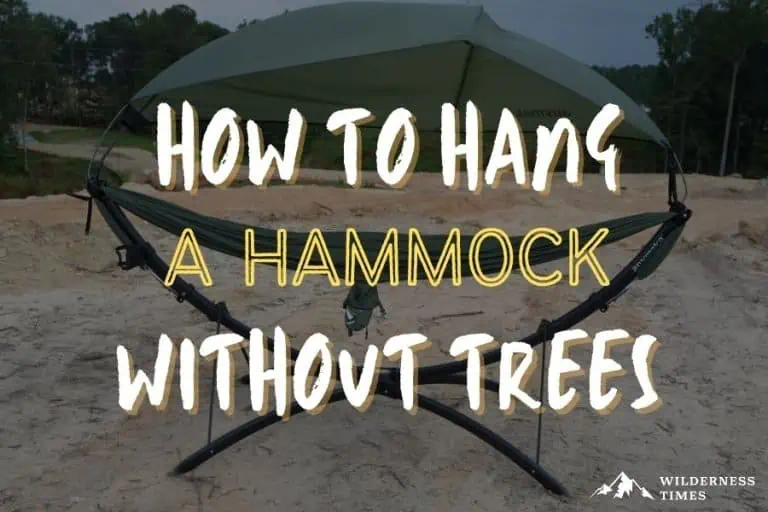When you think of hammocks, usually you imagine them hanging from trees.
Well, good news: there are lots of awesome ways you can hang your hammock even if there aren’t any trees around.
Whether you want to hang your hammock in the desert, on the beach, or in your backyard, there’s almost always a solution that you can make work.
In this article, you’ll learn how to hang a hammock without trees 4 ways in the wild, and 3 ways to do it in your backyard.
Ready?
Let’s start our journey towards carefree hammocking.
Table of Contents
Toggle4 Ways To Hang A Hammock Without Trees In The Wild
Hammock camping in the wild sometimes means staying at a campsite that lacks suitable trees for your sleeping area.
So, here are a few ways you can hang your hammock to try out on your next adventure.
Hammock Stands
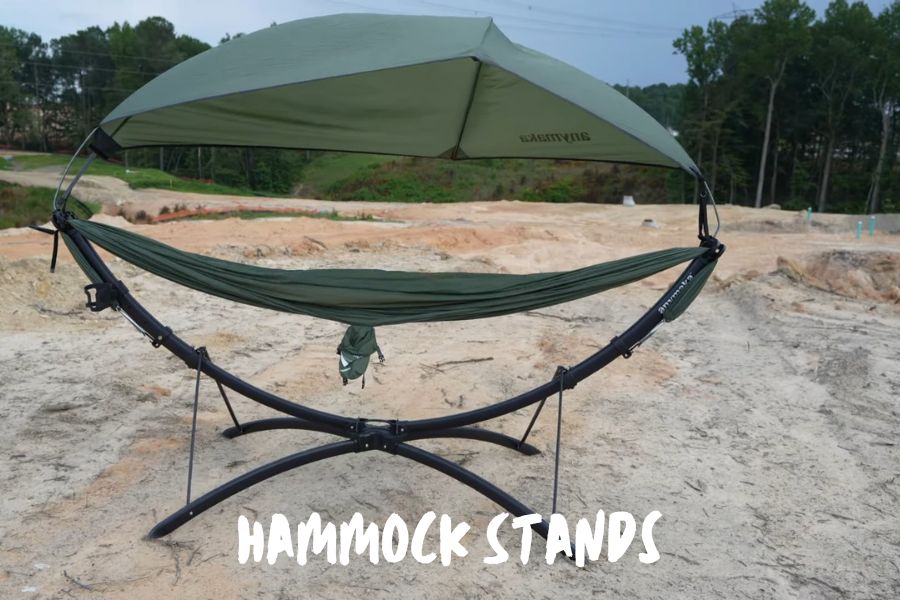
A hammock stand is one of the most convenient ways to make the whole world a hammock-friendly zone.
Hammock stands are usually two long supporting rails that are placed parallel to the ground.
Both ends of the rails are bent upward and stop at a height that is suitable for hanging your hammock. There might be hooks, rings, pulleys, or other devices at each end for securing the hammock.
There are many different types of hammock stands out there. So, when looking for the right hammock stand for your outdoor adventure, here are a few things to keep in mind:
- Setup: Your hammock stand shouldn’t require any special skills or tools to set it up.
- Portability: You should look for a lightweight model. That is easily packed and carried with your camping gear.
- Strength and durability: Your ideal stand should comfortably support your weight and not warp when you get in and out.
- Rainfly capability: If your hammock stand doesn’t already come with a rainfly, you should find one with a top rail so that you can attach a tarp on rainy days to stay dry.
Cars & Trucks
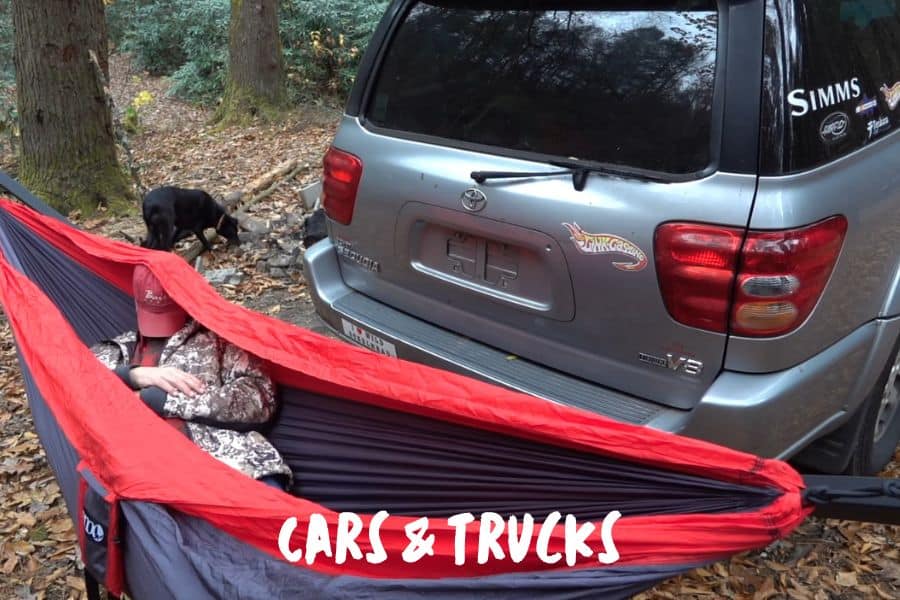
There are several ways you can use your car as an anchor point for pitching your hammock.
If you have two or more vehicles you can set up your hammock between them.
If you only have one car, you should bring along a wooden pole that you can pick up from any hardware store.
Now: if you have to go with the 1 car option, you’ll need to sweat a bit.
Dig a hole in the ground for your wooden pole, put it inside, and backfill the remaining space between the pole and the ground.
Be sure to put some rocks around your wooden pole to create a good support system. Make sure your wooden pole is firmly lodged in the ground. Shake your pole to check if it’s stable.
Then, drill a 1-inch hole in the top of the pole and insert an aluminum piece such as a drill part or screwdriver into the hole to ensure it doesn’t slip. Or, you can drill in a J-hook on the side of your wooden pole at your preferred height.
It is better to do this before setting out on your adventure so you don’t need to carry a drill with you.
Also at home, you can test out the perfect height for your J-hook.
Another option is to park your car near a boulder, tree, or structure which will serve as a secondary anchor point. On a side note – if you use a tree as an anchor point, make sure that you adhere to LeaveNoTrace principles and take care not to damage the tree.
To tie your hammock securely you’ll need a vehicle with a roof rack as well as some tree straps. Tie the straps to the part of the roof rack where it attaches to your car’s roof as this reduces the load on your vehicle.
Attach one end of your hammock to your roof rack and the other to a secondary anchor point to complete your camping setup for the night.
It’s important to note that finding the right attachment point is crucial. Otherwise, you may end up damaging your car.
For example, it is definitely not a good idea to attach your hammock to your rearview mirror.
Rocks

Another option for hammock camping without trees is rocks.
The good news is that securing your hammock to rocks is relatively easy.
To do so, find rocks that are 10 to 18 feet apart and make sure they’re big enough to hold your weight. This normally entails looking for boulders with a height of at least 6 to 8 feet.
You have a few choices for setting up your hammock on rocks.
You can create strong anchor points by tying very long pieces of webbing or tree straps around the boulders.
You can also use climbing equipment (such as cams and nuts) to anchor into the rock.
However, if you are going to use climbing equipment for your setup, make sure to inform yourself well on how to do so properly to avoid injury.
Poles
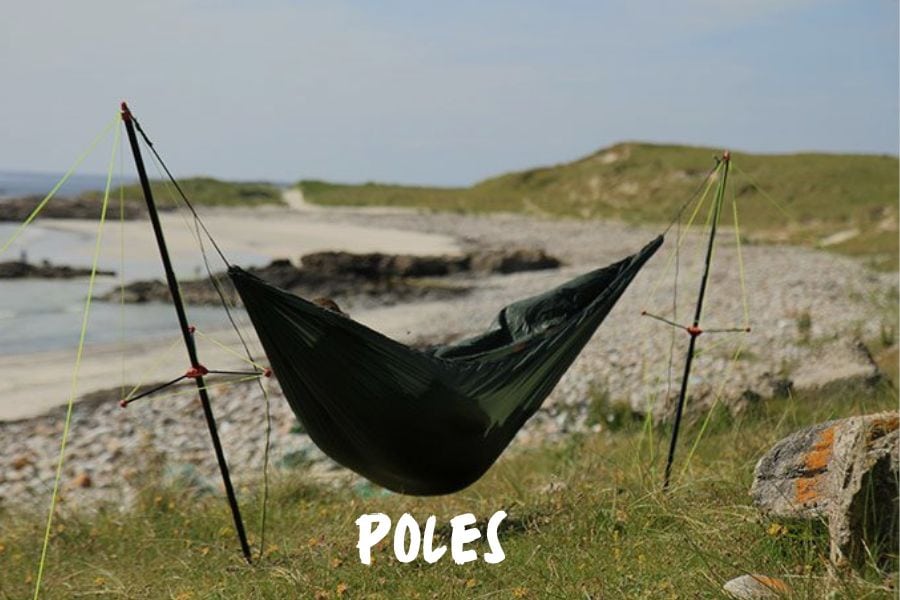
Poles and other round supports are ideal for securing your hammock.
A pole or post, such as a telephone pole or a fence post, can be found almost anywhere.
Choose your pole with care, ensuring that it is large and strong enough to support your weight. You should give it a good shake to ensure that it is stable.
More and more national and state parks are installing hammock posts for campers that are free to use. So this option will become even more available in the future.
3 Ways To Hang A Hammock Without Trees In Your Backyard
You do not need to have trees in your yard to enjoy chilling in a hammock. You only need two strong points, so that you can tie the ends of the hammocks.
Below you’ll learn some great for hanging your hammock ways to try out in your backyard or home.
Fences & Posts
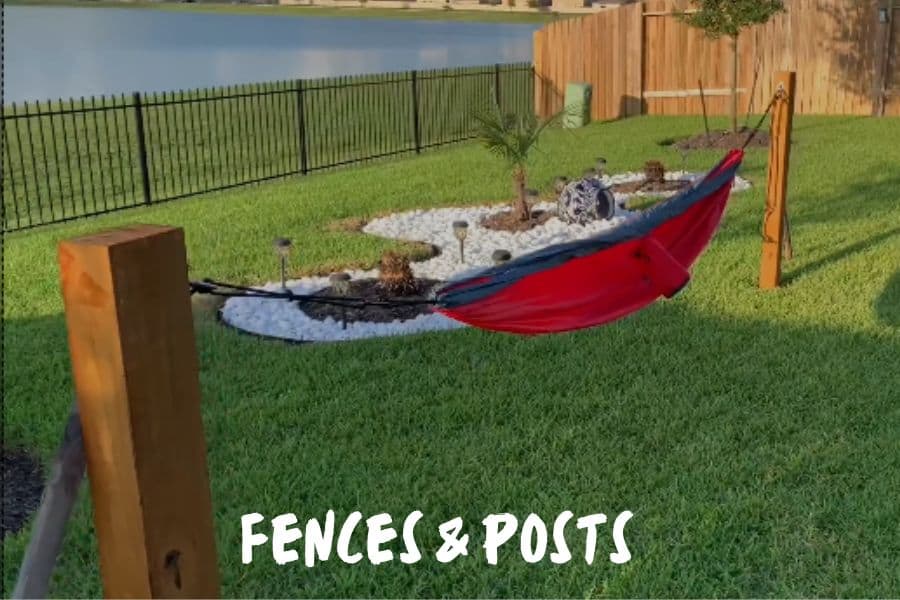
If your backyard is naked and treeless, fences and posts are an excellent alternative that you can use to set up your hammock.
If you have firm fences in your backyard, you can use them to hang your hammock.
You should have no trouble with the height of the fence posts. You can use any height you want as long as the fence posts are tall enough to keep your hammock above the ground.
The space between your fence posts should be several feet longer than the length of your hammock.
If you can’t find a suitable space distance, you can tie one end of your hammock to the fence, and install a post for the other end a suitable distance away.
Or, if you don’t have a fence at all, you can just install 2 posts.
Know that this method is a DIY project.
You should buy quality posts at a hardware store. Make sure that your posts have at least a 5-inch diameter and are 6 to 8 feet in height, or they won’t be able to support your weight while hammocking.
Once you’ve found an ideal hammocking spot for your posts, you’ll do the following:
- Dig two holes into the ground for your posts. These should be about 2 feet deep, 17 to 19 feet apart, and 5 to 7 inches wide.
- Place a post in each hole and backfill the holes with concrete. It’s important to seal up the posts in concrete to keep them from falling under pressure.
- Wait about 12 hours for the concrete to set.
- Fix J-hooks to each post to serve as anchors.
- Tie one end of your hammock to each post and adjust the tension until you get the perfect hang, in the shape of a smiley face.
Building A Hammock Structure
You may want to consider building a permanent hammock camping structure in your backyard.
This may be as basic as a homemade stand or as elaborate as a full-fledged weatherproof sleeping area.
A hammocking structure can be built in a variety of ways. You can fine-tune your design to fit your budget and available space.
The idea behind most of these hammocking structures is essentially similar to that of making hammocking anchors out of posts.
Creating a full-fledged structure, however, allows you to take your design to the next level.
Buildings Or Sturdy Structures

When hammocking at home, you can also use buildings as anchor points.
Columns, banisters, and joists are all examples of strong building structures that can be used as excellent pitching locations.
You can also tie one end of the hammock to the structure and install a sturdy post at the other end to provide support.
Be cautious when attaching the hammock to the building. To tie the cords, you’ll need strong J-hooks or eye screws, and the hardware must be secured to a strong part of the structure.
Because the siding cannot support the weight of a person in a hammock, the hardware must pass through the siding and into a wall stud.
What’s next?
There are different ways for hanging your hammock in the wild, and hanging your hammock in your backyard. However, some methods can be used in both situations.
Hammock stands can serve you in your backyard as well as in the wild.
If you have a big backyard, you can park your vehicle or vehicles in the yard and use them to hang your hammock.
Also, if you are somewhere in the wild and there are building structures such as cabins, toilets, etc., you can use them to set up your hammock as well.
Now: whichever way you go for, be sure to test out the endurance of your setup, before tucking yourself in for a good night’s sleep.
Slip in and out of your hammock to see if it holds on well.
If it does, you are ready to fully enjoy your treeless hammock setup!


